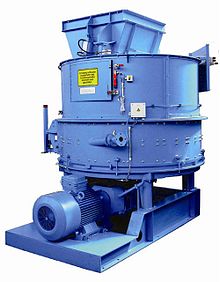Sand mixer

In foundry technology, a sand mixer is a machine that mixes the individual components of the molding material required for sand casting - sand, binding agent and water . There are different designs of sand mixers, which can be divided into discontinuous mixers and continuous mixers (often also referred to as continuous mixers). In the case of discontinuous mixers, a certain amount of molding material is poured into the empty mixer, mixed and then the mixer is completely emptied. With continuous mixers, on the other hand, molding material is continuously added and removed. For this purpose, continuous mixers often have an inclined container through which the molding material slowly passes.
Designs
Paddle mixer
Paddle mixers consist of a mostly cylindrical base body for receiving the molding material. Inside this main body there is a rotating shaft to which blades are attached, which ensure that the molding material is mixed. Paddle mixers are popular for molding mixes in which waterglass , oil or liquid resin are used as binders . Paddle mixers are also often used to mix the sand for cores .
Pan mixer
The pan mixer consists of a pan mill , which kneads and compresses the molding material, and a swirler, which loosens it up again. The cylindrical rollers of the pan mill usually press the molding material against the bottom and less often against the side wall of the container. Pan mixers are used for particularly plastic molding materials that are too tough for paddle mixers, and for most molding materials with clay as a binder.
Countercurrent mixer
The principle of the countercurrent mixer is to let the molding material rotate in two opposite directions. Mixing takes place at the point where the two swirls of molding material meet. The rotation of the molding material is ensured by two vortices that run in opposite directions. Alternatively, a single vortex can be positioned centrally in the container while the container itself is rotating in the opposite direction. There are also countercurrent mixers in which the container bottom is moved.
One advantage of countercurrent mixers is that the electrical energy required to operate the mixer is completely absorbed when the molded material particles collide with one another, while with other designs molded material hits the container wall at high speeds and loses its kinetic energy .
Spray mixer
Spray mixers can be used when all the additives to the molding sand are in liquid form. The molding sand is set in rapid rotation; the additives are then sprayed in via nozzles .
literature
- Ernst Brunhuber (Ed.): Giesserei Lexikon. Fachverlag Schiele & Schön, 16th edition, Berlin 1994, ISBN 3-7949-0561-X , pp. 998-1004.
